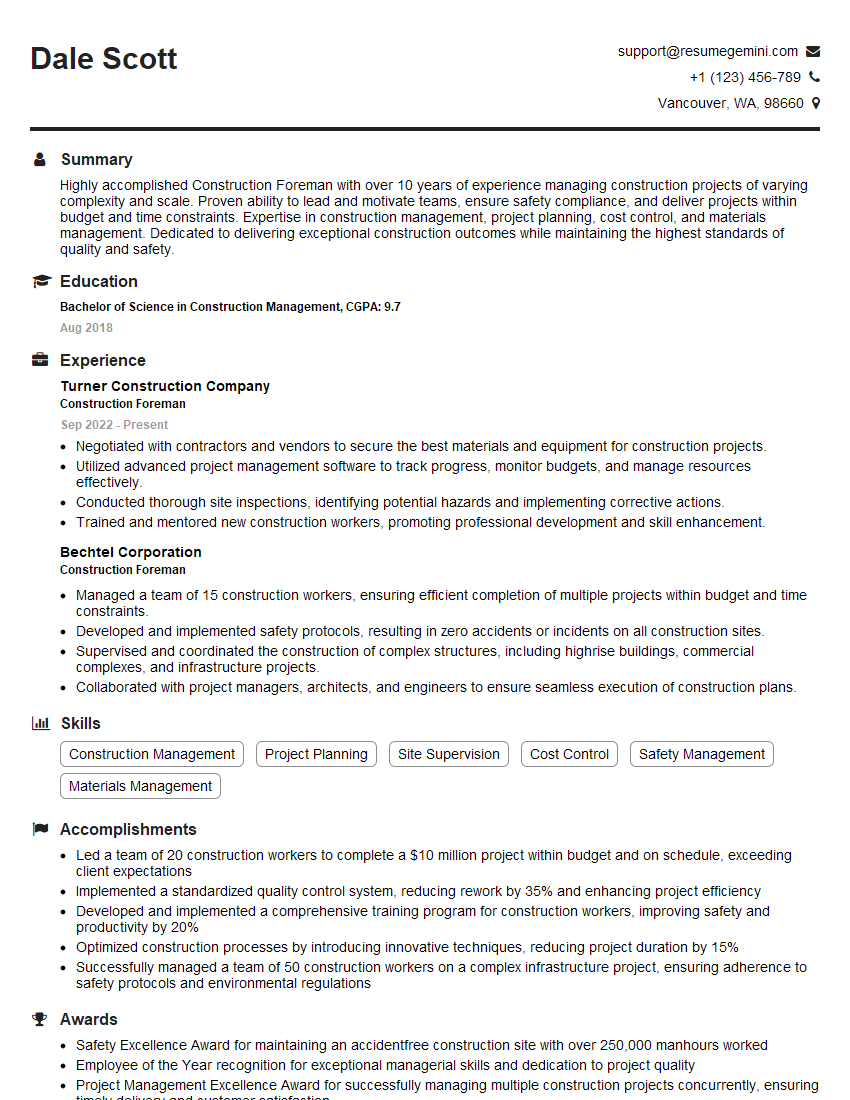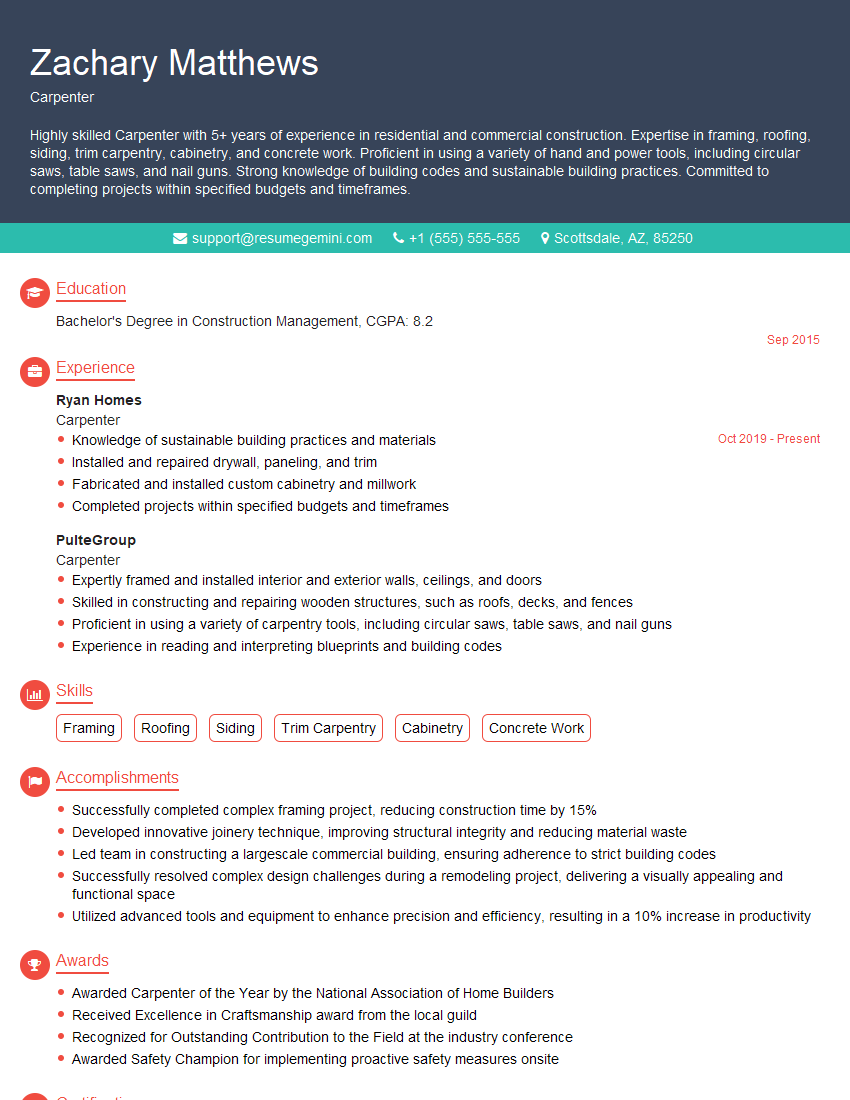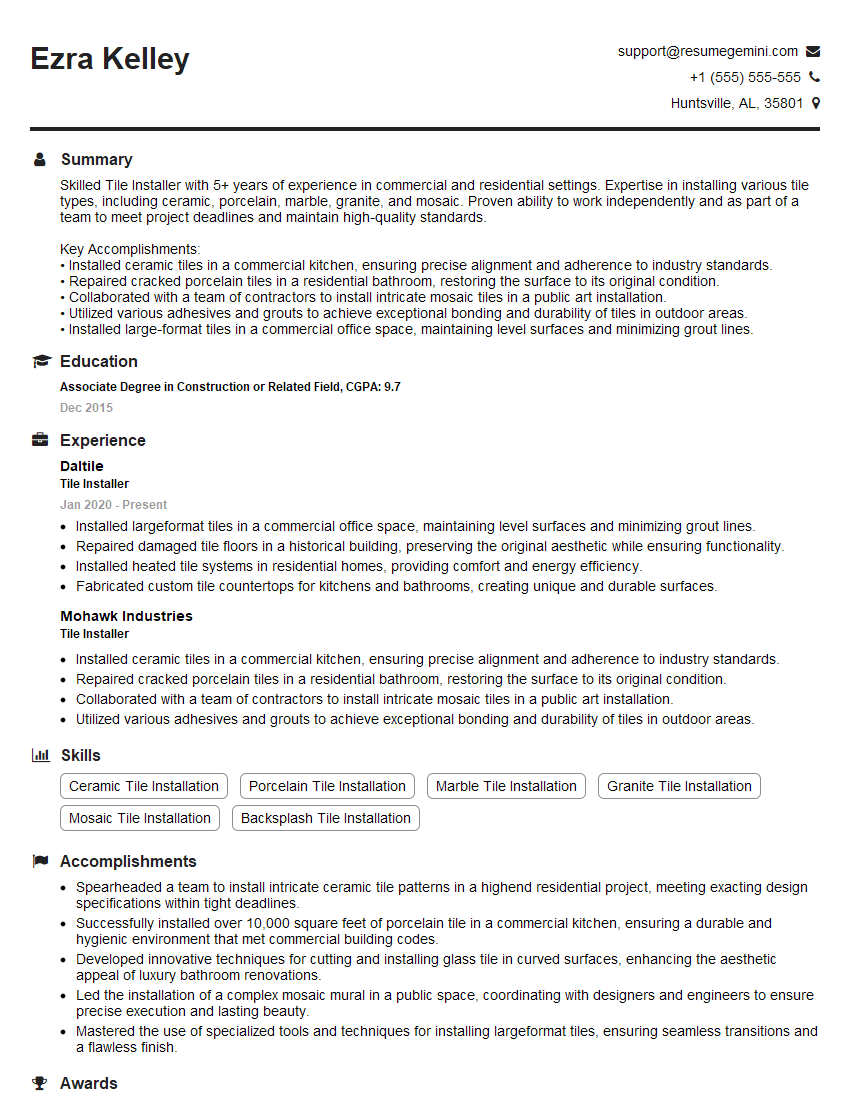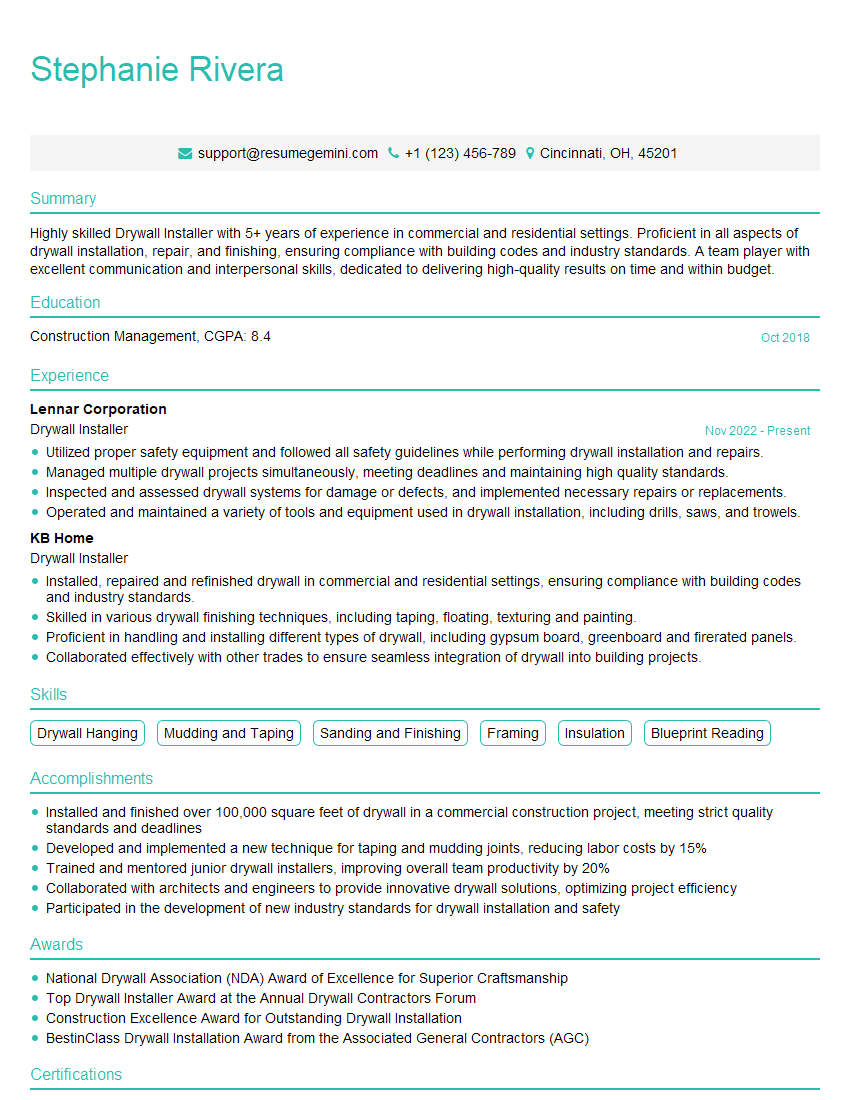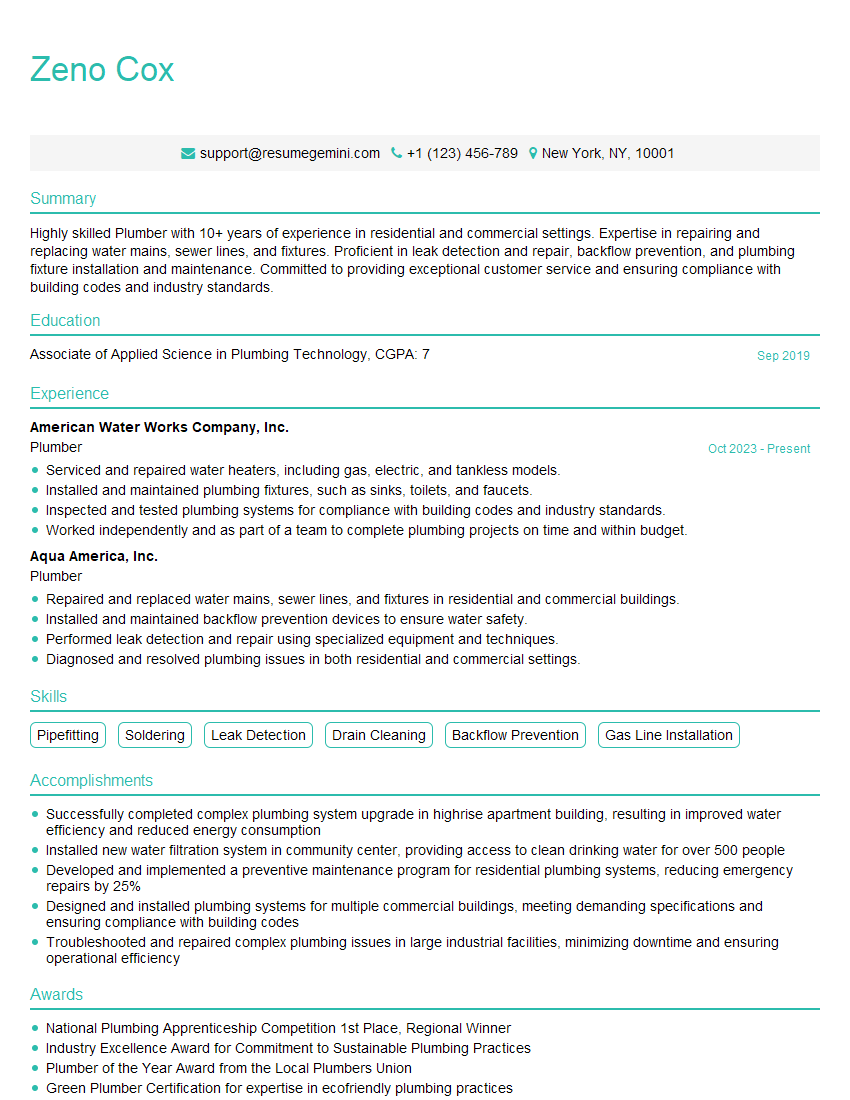The thought of an interview can be nerve-wracking, but the right preparation can make all the difference. Explore this comprehensive guide to Laser Level and Measurement Tools interview questions and gain the confidence you need to showcase your abilities and secure the role.
Questions Asked in Laser Level and Measurement Tools Interview
Q 1. Explain the different types of laser levels available.
Laser levels come in various types, each designed for specific applications. The primary distinctions lie in their beam patterns, working ranges, and functionalities.
- Point Lasers: These project a single, highly visible point. They are ideal for simple tasks like marking a single point on a wall or aligning pictures.
- Line Lasers: These project a continuous line, useful for aligning shelves, hanging wallpaper, or setting up drywall. They can project one, two, or three lines (horizontal, vertical, and plumb).
- Rotary Lasers: These rotate 360 degrees, creating a full plane of laser light. They’re excellent for large-scale projects like land surveying, construction, or leveling large areas. They often require a receiver to detect the laser beam at longer distances.
- Self-Leveling vs. Manual Leveling: Most modern laser levels are self-leveling, meaning they automatically compensate for minor inclines. Manual leveling lasers require precise adjustment using leveling screws.
- Cross-Line Lasers: A very common type, combining both horizontal and vertical lines in one unit, perfect for many indoor tasks.
Choosing the right type depends entirely on the scale and nature of your project. A point laser is sufficient for simple tasks, while a rotary laser is necessary for large-scale construction.
Q 2. Describe the principles behind laser leveling technology.
Laser leveling technology relies on the principle of a precisely controlled laser beam. A pendulum or other stabilization mechanism ensures the laser diode remains perfectly level, even on uneven surfaces (in self-leveling models). The laser emits a coherent beam of light, which creates a very straight line or plane. This line or plane serves as a reference for leveling and alignment tasks. In rotary lasers, a rotating motor spreads the beam to cover a larger area, creating a horizontal or vertical plane. The accuracy is dependent on the quality of the laser diode, its stabilization system, and the overall construction of the device.
Think of it like a perfectly straight, invisible string stretching across the room. You can use this ‘string’ as a reference point to ensure everything else is perfectly level.
Q 3. How do you ensure the accuracy of a laser level?
Ensuring accuracy is paramount. It involves several steps:
- Calibration: Regular calibration is essential to maintain accuracy. This typically involves comparing the laser’s output to a known reference point using a calibration device.
- Proper Setup: Correctly positioning and leveling the laser level is critical. The self-leveling feature significantly reduces human error but isn’t foolproof.
- Environmental Factors: Temperature, humidity, and strong electromagnetic fields can affect accuracy. Use the laser level within its specified operating conditions.
- Laser Class: Pay attention to the laser class (e.g., Class 2 or Class 3R). Class 2 lasers are generally safer for indoor use, while Class 3R lasers offer better visibility but require more precautions. Always adhere to the manufacturer’s safety guidelines.
- Quality of Equipment: Invest in a high-quality laser level from a reputable manufacturer.
A significant drop in accuracy could indicate a malfunction needing professional attention.
Q 4. What are the common calibration methods for laser levels?
Calibration methods vary depending on the laser level type. Most self-leveling models are internally calibrated and usually don’t allow for user adjustment. However, some high-end units might provide adjustments accessible through service menus. Rotary lasers often require more extensive calibration using specialized equipment and procedures. These procedures might involve:
- Using a known reference point (e.g., a precisely leveled surface). The laser’s readings are then compared to this reference to check for any deviation.
- Employing calibration targets and measuring tools to accurately determine the laser’s output against known standards.
It’s crucial to only attempt calibration if you are adequately trained and have the necessary tools. Otherwise, contact a qualified professional or the manufacturer.
Q 5. Explain the importance of self-leveling capabilities in laser levels.
Self-leveling is a crucial feature in laser levels, significantly enhancing ease of use and accuracy. It automatically compensates for minor tilts and inclines (usually within a range of ±3° to ±5°), ensuring the laser beam remains perfectly level or plumb. This feature greatly reduces the time and effort required for setup. Without it, manually leveling the laser would be time-consuming and prone to errors, making accurate measurements more challenging.
Imagine trying to hang a picture perfectly straight without a self-leveling laser—it would involve a lot of trial and error! Self-leveling makes the process incredibly efficient.
Q 6. What are the limitations of laser levels in various environmental conditions?
Environmental conditions can greatly impact the performance and accuracy of a laser level:
- Direct Sunlight: Bright sunlight can wash out the laser beam, making it difficult to see.
- Dust and Debris: Dust or other particles in the air can scatter or absorb the laser beam, reducing visibility and accuracy.
- Temperature Extremes: Extreme heat or cold can affect the laser’s internal components, potentially impacting accuracy. Always operate within the specified temperature range.
- Vibration: Significant vibrations can disrupt the laser’s internal mechanisms, making it difficult to maintain a stable beam.
- Electromagnetic Interference: Strong electromagnetic fields can interfere with the laser’s operation.
Understanding these limitations is key to selecting the right laser level and using it effectively in different environments. For example, using a rotary laser with a receiver is recommended for outdoor projects where sunlight is a concern.
Q 7. How do you choose the appropriate laser level for a specific task?
Choosing the right laser level hinges on the specific application and project requirements:
- Project Size and Scope: Small tasks (e.g., hanging pictures) need a simple point or line laser. Larger projects (e.g., construction) often require a rotary laser.
- Accuracy Requirements: The accuracy needed dictates the laser level’s precision class.
- Working Range: Determine the distance the laser beam needs to reach. Some lasers only work within short ranges, while others have ranges extending hundreds of feet (especially rotary lasers with receivers).
- Environmental Conditions: Consider the environment – a ruggedized laser may be necessary for outdoor use.
- Budget: Laser levels range in price, with basic models costing less than sophisticated ones.
- Features: Additional features such as pulse mode (for use with detectors in bright sunlight), multiple line projection, and self-leveling capabilities will impact the choice.
Carefully considering these factors will ensure you choose a laser level perfectly suited to your needs, maximizing efficiency and accuracy.
Q 8. Describe different types of measurement tools used in conjunction with laser levels.
Laser levels are incredibly versatile, and their accuracy is greatly enhanced by using them in conjunction with various measurement tools. Think of the laser as providing the reference points, while other tools provide the precise distances and details.
Laser Distance Meters (LDMs): These handheld devices measure distances with incredible precision, often within millimeters. They’re crucial for accurately transferring the laser’s plane to a specific point, especially when dealing with longer distances.
Measuring Tapes: While less precise than LDMs, measuring tapes remain essential for shorter distances and quick verification. They’re invaluable for double-checking measurements and are incredibly useful for measuring in areas where a laser can’t reach.
Digital Levels: These provide accurate readings of inclination and elevation, complementing the laser level’s horizontal and vertical references. They are helpful when working on uneven terrain or needing to establish precise grade.
Total Stations (discussed in more detail below): These advanced surveying instruments integrate distance measurement, angle measurement, and data logging. They offer the highest level of precision and are often used in large-scale construction and surveying projects.
Leveling Rods/Staffs: These are used in conjunction with optical levels and total stations to determine elevations. They provide a clear, graduated target for the instrument to read.
For example, imagine installing ceiling tiles. The laser level establishes the horizontal plane, but an LDM ensures each tile is precisely spaced and at the correct height.
Q 9. Explain the use of total stations in surveying and construction.
Total stations are sophisticated surveying instruments that combine electronic distance measurement (EDM), angle measurement (both horizontal and vertical), and data recording capabilities. They are the workhorses of large-scale projects.
In surveying, total stations are used to create highly accurate maps and site plans. They can measure distances to remote points, determine precise elevations, and calculate coordinates. This data is crucial for land boundary definition, topographical mapping, and volume calculations.
In construction, total stations are essential for setting out building layouts, verifying the accuracy of foundations, and monitoring structural alignment. They ensure that structures are built according to the design specifications with minimal deviation. For instance, imagine constructing a high-rise building – total stations would be used to precisely locate columns, beams, and walls, ensuring the structural integrity of the entire project.
Data collected by a total station is often processed using surveying software, allowing for the creation of detailed drawings, 3D models, and comprehensive site reports.
Q 10. How do you interpret measurements from a laser distance meter?
Interpreting measurements from a laser distance meter (LDM) is usually straightforward, but care must be taken. Most LDMs display the distance directly, but understanding what that distance represents is key.
Consider these points:
Units: Ensure the device is set to the correct units (meters, feet, etc.). A simple mistake here can lead to significant errors.
Reference Point: Understand where the distance is measured *from*. Is it from the front edge of the device, the center, or some other calibrated point? The manual will clarify this.
Continuous vs. Single Measurement: Some LDMs offer continuous measurement, updating the distance as the device moves. Others require a single button press for each measurement. Make sure you understand which mode you’re using.
Environmental Factors: Extreme temperatures or atmospheric conditions (like dust or fog) can affect the accuracy of the measurement. Be aware of these and factor them in as necessary.
Reflectivity of the Target: The surface you’re measuring to affects accuracy. A highly reflective surface provides the best results; a dark, porous surface might lead to inaccuracies.
For example, if you’re measuring the width of a room, ensure that the laser is pointed directly at the opposite wall, and that the reading you receive accounts for the LDM’s measurement reference point. Always take multiple measurements and average them to minimize error.
Q 11. What are the safety precautions when using laser levels?
Safety is paramount when using laser levels. The laser beam, even at low power, can be harmful to the eyes. These precautions are essential:
Eye Protection: Always wear appropriate laser safety eyewear. The eyewear should be rated for the specific laser class of your level. Never look directly into the laser beam.
Warning Signs: Post warning signs in the area to alert others to the presence of the laser beam. This is especially important in areas with high foot traffic.
Proper Setup: Ensure the laser level is securely mounted to prevent accidental movement or falls. Never point the laser at anyone intentionally, or leave the laser turned on unattended.
Class of Laser: Understand the classification of your laser level (e.g., Class 2, Class 3R). This classification indicates the potential hazard and the necessary safety precautions. Higher class levels necessitate stricter safety measures.
Weather Conditions: Avoid using the laser in adverse weather conditions such as heavy rain or fog, as this can affect the accuracy and safety of the instrument. High temperatures may also reduce battery life.
Always consult the manufacturer’s instructions for specific safety guidelines related to your particular laser level model.
Q 12. Describe different types of laser level mounts and accessories.
Laser level mounts and accessories greatly expand the versatility and usefulness of the instrument. The type of mount depends on the application and the environment.
Tripods: These are essential for stability, especially for precise measurements over longer distances. Choose a tripod with adjustable height and a sturdy base.
Magnetic Mounts: These are convenient for attaching the laser level to metal surfaces, such as steel beams or pipes. They are quick and efficient in metal-rich environments.
Wall Mounts: These allow for permanent or semi-permanent installation of the laser level on walls or ceilings. This is useful in situations where regular alignment is not required.
Rotating Bases: These allow for precise adjustment of the laser level’s orientation, crucial for aligning multiple planes or adjusting the angle of inclination.
Target Plates: These are used to increase the visibility and accuracy of the laser beam at longer distances, especially when working outdoors or in brightly lit areas.
Remote Controls: Remote controls allow for convenient operation of the laser level, especially when working in awkward positions or at heights.
Imagine setting up a laser level for a drywall installation. You might use a tripod for initial setup, then possibly a magnetic mount to fine-tune alignment against a metal stud.
Q 13. Explain the concept of beam divergence in laser levels.
Beam divergence refers to the widening of the laser beam as it travels from the source. It’s measured in milliradians (mrad) or degrees. A lower divergence means a narrower beam, resulting in greater precision at longer distances. Think of it like a flashlight: a highly focused flashlight has low divergence, while a wider beam flashlight has high divergence.
The beam divergence is a crucial specification to consider when selecting a laser level. A lower divergence is generally preferable for precise leveling over long distances. However, a wider beam can be advantageous in some situations, such as when working in bright conditions or over rough terrain.
For example, a laser level with a divergence of 0.5 mrad will maintain a tighter beam over a longer range compared to one with a divergence of 2 mrad. The tighter beam will minimize error in leveling.
Q 14. How do you handle issues such as laser beam interference?
Laser beam interference occurs when multiple laser beams intersect or when the beam is reflected unexpectedly. This can lead to inaccurate readings and make it difficult to establish a clear reference point.
Here’s how to handle such issues:
Identify the Source: First, pinpoint the source of the interference. Is it another laser, a reflective surface, or something else? This will dictate how to best address the issue.
Adjust Laser Position: Try repositioning the laser level or adjusting the angle to minimize the overlap or reflection. This is often the simplest solution.
Shielding: If the interference is coming from a reflective surface, consider using a shield or barrier to block the unwanted reflections. A simple piece of cardboard could suffice in some cases.
Turn Off Other Lasers: If the interference is coming from another laser, the simplest solution may be to temporarily turn off the other laser to perform the measurement without interference. This helps isolate the laser beam and maintain accuracy.
Different Wavelengths: In more complex scenarios, using a laser level with a different wavelength from other lasers on-site can mitigate interference issues. This is more relevant in industrial settings with multiple laser systems.
For instance, if you’re using a laser level outdoors and the beam is reflecting off a window, using a shield or repositioning the laser would solve this issue, restoring the accuracy of your measurement.
Q 15. How do you compensate for environmental factors affecting measurements?
Environmental factors like temperature, humidity, and even air pressure can significantly impact laser measurement accuracy. Compensation involves understanding these influences and applying corrective measures. For instance, temperature affects the refractive index of air, causing the laser beam to bend slightly. Many high-end laser levels have internal temperature sensors and automatically compensate for this. For simpler models, we might consult temperature correction charts provided by the manufacturer. Similarly, humidity can affect the refractive index, though usually to a lesser extent than temperature. For extreme conditions, especially those involving significant temperature gradients or atmospheric pressure changes over long distances, more sophisticated techniques are needed, which may include using atmospheric modeling software to calculate the correction factor and applying that to the raw measurement. Think of it like aiming a bow and arrow on a windy day – you need to adjust your aim to compensate for the wind’s effect.
In practice, this often involves a combination of:
- Using instruments with automatic temperature compensation.
- Performing measurements under stable environmental conditions whenever possible.
- Referring to manufacturer’s specifications and correction charts.
- Employing specialized software for atmospheric correction in demanding applications.
Career Expert Tips:
- Ace those interviews! Prepare effectively by reviewing the Top 50 Most Common Interview Questions on ResumeGemini.
- Navigate your job search with confidence! Explore a wide range of Career Tips on ResumeGemini. Learn about common challenges and recommendations to overcome them.
- Craft the perfect resume! Master the Art of Resume Writing with ResumeGemini’s guide. Showcase your unique qualifications and achievements effectively.
- Don’t miss out on holiday savings! Build your dream resume with ResumeGemini’s ATS optimized templates.
Q 16. Explain the importance of proper maintenance of laser levels.
Proper maintenance of laser levels is crucial for ensuring accurate and reliable measurements, prolonging their lifespan, and maintaining safety. Neglecting maintenance can lead to inaccurate readings, malfunction, and even potential hazards. Think of it like regularly servicing your car – preventative maintenance is far cheaper and safer than dealing with major breakdowns later. My typical maintenance routine includes:
- Regular Cleaning: Gently cleaning the lens with a soft, lint-free cloth to remove dust and debris is paramount. Avoid harsh chemicals or abrasive materials that could scratch the lens.
- Checking the Leveling Mechanism: Ensure the self-leveling mechanism is functioning correctly and the laser lines are plumb and level. If there are any deviations, I’d investigate for potential mechanical issues.
- Battery Care: Using appropriate batteries, avoiding overcharging, and storing the instrument properly are crucial for battery health. Low battery power can affect the laser’s stability.
- Storage: Storing the laser level in a cool, dry place in its protective case helps prevent damage and ensures longevity.
- Calibration: Periodic professional calibration ensures the device maintains its accuracy. The frequency of calibration will depend on the intensity of use and manufacturer recommendations.
Q 17. How do you troubleshoot common problems with laser levels?
Troubleshooting laser levels often involves a systematic approach. I start by identifying the symptoms: Is the laser not turning on? Are the lines faint or inaccurate? Does the self-leveling mechanism fail?
Here’s a common troubleshooting flow:
- Check Power Source: Ensure fresh batteries are correctly installed and make sure the power switch is engaged.
- Inspect the Lens: Clean the lens thoroughly. A dirty lens is a common cause of faint or blurry lines.
- Verify Leveling Mechanism: Check if the self-leveling function is working properly. If not, it may require adjustment or repair. Operating the laser outside its self-leveling range can also result in inaccurate measurements.
- Examine the Laser Lines: Uneven or inaccurate lines might indicate internal misalignment.
- Check Environmental Factors: Extreme temperatures or interference can affect laser performance.
- Refer to the Manual: The manufacturer’s manual provides valuable troubleshooting information and diagrams.
If the problem persists, contacting the manufacturer or a qualified repair technician is the next step.
Q 18. Describe your experience using various software applications for data processing and analysis from laser measuring devices.
I have extensive experience using various software applications for processing and analyzing data from laser measurement devices. This often involves software tailored to specific laser measurement tools or more general-purpose data analysis software. For instance, I’ve used programs that can directly interface with laser distance meters (LDMs) to record measurements, calculate areas, volumes, and generate reports in various formats (e.g., CSV, DXF). Others allow for point cloud processing and 3D modeling based on data acquired by laser scanners. General-purpose software such as spreadsheets (like Excel or Google Sheets) is often used for basic data manipulation and visualization. Statistical software packages, like R or SPSS, are valuable for in-depth analysis of larger datasets to identify trends and anomalies.
For example, in one project involving building surveys, I used a software package that imported data from a total station and laser scanner. This allowed us to generate highly accurate 3D models of the structures, helping to identify potential structural issues or deviations from design specifications. Efficient data processing is key to minimizing errors and saving time in construction and surveying projects.
Q 19. How do you ensure the accuracy of measurements when dealing with long distances?
Ensuring accuracy over long distances requires careful consideration of several factors. Atmospheric conditions significantly impact accuracy at longer ranges due to the refraction of the laser beam. To compensate for this:
- High-Precision Instruments: Using laser levels and distance meters with long-range capabilities and automatic atmospheric correction is crucial.
- Multiple Measurements: Taking multiple measurements from different angles and averaging the results helps mitigate errors caused by atmospheric conditions or instrument drift.
- Atmospheric Modeling Software: For extremely long distances, sophisticated atmospheric modeling software is used to accurately predict and compensate for the effects of air temperature, pressure, and humidity on the laser beam.
- Reference Points: Establishing known reference points at intermediate distances helps break down the measurement into smaller, more manageable segments. This reduces the impact of cumulative errors.
- Proper Calibration: Regularly calibrating the equipment with traceable standards is necessary to maintain a high level of accuracy.
Imagine measuring the width of a wide river – you wouldn’t rely on a single measurement from one bank. You might use multiple measurements, possibly even including landmarks and triangulation to ensure accuracy.
Q 20. What are the differences between rotary and line lasers?
Rotary and line lasers are both used for leveling and alignment, but they differ in how they project the laser beam:
- Rotary Lasers: Project a 360-degree rotating laser beam, creating a horizontal or vertical plane. This is ideal for large-scale leveling applications like grading land or establishing floor levels in large buildings. They are usually more expensive and require more setup time.
- Line Lasers: Project one or more straight lines (horizontal, vertical, or both). They are more compact and easier to use for smaller projects like hanging pictures, tiling walls, or setting up cabinets. Line lasers are often more user-friendly and cost-effective.
The choice between a rotary and line laser depends entirely on the application. Rotary lasers are best for large areas and tasks needing precise leveling across a wide range, while line lasers are perfect for smaller, more localized tasks where precise alignment is required.
Q 21. What are the advantages and disadvantages of using laser levels compared to traditional methods?
Laser levels offer several advantages over traditional leveling methods such as plumb bobs and spirit levels:
- Increased Accuracy: Laser levels provide significantly higher accuracy, particularly over longer distances.
- Improved Speed and Efficiency: Laser levels greatly reduce the time and effort needed for leveling and alignment.
- Enhanced Visibility: Laser lines are easily visible, even in bright conditions, improving overall efficiency.
- One-Person Operation: Many laser level tasks can be performed by a single person.
However, there are also some disadvantages:
- Cost: Laser levels can be more expensive than traditional tools.
- Sensitivity to Environmental Factors: Extreme temperatures, vibration, or strong sunlight can affect accuracy.
- Eye Safety: Direct eye exposure to laser beams can be hazardous; safety glasses are always required.
- Calibration Needs: Regular calibration is necessary to maintain accuracy.
The decision of whether to use a laser level versus traditional methods depends on the project’s scale, precision requirements, budget, and environmental factors.
Q 22. Explain the concept of plumb bobs and their use in conjunction with laser levels.
Plumb bobs are simple yet effective tools used to establish a perfectly vertical reference point. They consist of a pointed weight suspended from a string. In conjunction with laser levels, plumb bobs provide a crucial ground-truth verification. Imagine you’re leveling a foundation; the laser level might indicate a plane, but a plumb bob dropped from the laser’s projected point onto the foundation ensures that point is truly vertical, verifying the accuracy of the laser’s level.
For example, if we are setting a foundation wall and using a rotary laser level to project a level plane, we would use a plumb bob to transfer that level point precisely from the laser’s projected line down to the ground. The bob ensures accurate alignment, especially in situations where the laser beam might be slightly obstructed or difficult to see clearly at the lower levels.
Q 23. Describe different methods of transferring points using laser technology.
Transferring points accurately with laser technology involves several methods. One common technique is using laser pointers for short-range work. This directly projects the point onto the target. For longer distances or more complex layouts, we use laser receivers. These receivers detect the laser beam and provide an audible or visual signal, allowing for precise point marking, even in bright sunlight or challenging environments.
Another sophisticated method utilizes total stations. These combine laser technology with electronic distance measurement (EDM) to precisely measure distances and angles, enabling the transfer of points with incredible accuracy over considerable distances. Think of laying out the foundation of a large building; a total station provides a superior level of precision compared to simpler laser pointers.
- Direct Projection: Simple, effective for short distances.
- Laser Receivers: Improves accuracy and range, especially outdoors.
- Total Stations: High-precision, suitable for large-scale projects requiring precise measurements and point transfers.
Q 24. How do you manage data from multiple laser level readings?
Managing data from multiple laser level readings often involves using laser level software or data logging capabilities built into advanced levels. This data is typically in the form of distance readings, angles, and sometimes level information. The software allows you to organize the readings according to their location and reference points. It also often allows for calculating averages, checking for inconsistencies, and generating reports for project documentation.
In simpler scenarios, I’d often use a spreadsheet program (like Excel) to record readings manually, ensuring clear labeling of each reading’s location and context. Consistency and careful record-keeping are key to preventing errors in interpretation. In cases of significant data volume or if complex calculations are required, dedicated surveying software is essential for managing, analyzing and interpreting the data.
Q 25. Describe your experience with different types of targets used in conjunction with laser levels.
My experience encompasses a wide range of targets, each suited for different applications. Simple round targets are ideal for general-purpose leveling. For longer distances or low-light conditions, high-visibility targets with retroreflective materials significantly enhance the beam’s visibility. For extreme conditions, digital targets or those with integrated sensors offer precise readings and improved accuracy.
I’ve worked with everything from basic paper targets to sophisticated digital receivers integrated with total stations. The choice of target depends heavily on the specific project requirements, the distance, environmental factors, and the desired level of accuracy. For instance, working with a total station in a dense forest might necessitate high-visibility targets, while basic paper targets suffice for interior leveling tasks within a small room.
Q 26. How do you ensure the safety of others while using laser levels on a jobsite?
Safety is paramount. Before starting any work involving laser levels, I ensure that the area is cleared and that all personnel are aware of the laser’s operation. Visible warning signs are posted, and appropriate eye protection is worn, especially with higher-powered lasers. For rotary lasers, I use appropriate warning lights or tapes to mark the operational area. It’s crucial to communicate consistently and effectively with everyone on the site about the laser’s operation to mitigate any risk of accidental exposure.
I also make sure that the laser is properly calibrated and is functioning as it should be to prevent misaligned beams causing misinterpretations and errors. Regular checks of the laser’s output are part of my standard operating procedure. In cases where it’s not practical to shut down the laser, I may choose more appropriate protective measures to safeguard anyone passing by the laser’s projection beam.
Q 27. Describe a situation where you had to troubleshoot a laser level malfunction.
I once encountered a situation where a rotary laser was producing erratic readings. The first step was to check the battery levels and ensure the unit was properly leveled and positioned. However, the problem persisted. I systematically checked the laser’s alignment using a known level reference. I then verified the condition of the internal components by carefully examining the laser’s mechanics and the leveling system. Turns out, a small amount of debris had accumulated in the leveling mechanism causing friction and affecting the rotary motion.
After carefully cleaning the leveling mechanism, the laser operated correctly. This highlighted the importance of regular maintenance and the need for a systematic troubleshooting approach, starting with simple checks and then moving towards more intricate solutions only after simpler solutions have been ruled out. I documented the issue and the resolution for future reference.
Q 28. How do you stay up-to-date with advancements in laser level and measurement technology?
Staying current is essential in this rapidly evolving field. I regularly attend industry conferences and workshops, where I network with other professionals and learn about the latest advancements in laser technology and measurement techniques. I subscribe to industry journals and online publications that offer in-depth technical analyses. I also actively participate in online forums and discussion groups where professionals share their experiences and insights. Finally, I make sure that I regularly train on new equipment and software, ensuring that my skills remain highly relevant.
Keeping abreast of new developments in laser technology is crucial for maintaining my competitive edge and for ensuring I’m employing the most efficient and accurate methods in my work. This commitment to continuous professional development is essential in this constantly evolving field.
Key Topics to Learn for Laser Level and Measurement Tools Interview
- Laser Principles: Understanding laser beam characteristics (coherence, divergence, wavelength), and how these impact accuracy and range in measurement tools.
- Leveling Techniques: Mastering different leveling methods (automatic, manual), their applications in various construction and surveying scenarios, and limitations of each.
- Measurement Technologies: Familiarize yourself with different measurement principles employed (time-of-flight, triangulation, phase-shift), and their respective advantages and disadvantages.
- Accuracy and Calibration: Understanding sources of error in laser measurement, calibration procedures, and the importance of maintaining instrument accuracy.
- Data Acquisition and Analysis: Learn how to effectively collect and interpret data from laser level and measurement tools, including data processing and error analysis.
- Safety Procedures: Understanding laser safety regulations, proper handling of laser equipment, and eye protection protocols.
- Practical Applications: Explore diverse applications in construction (alignment, leveling, distance measurement), surveying (topographical mapping, site surveys), and other relevant industries.
- Troubleshooting and Maintenance: Develop problem-solving skills to diagnose common issues with laser tools and perform basic maintenance procedures.
- Different Tool Types: Gain familiarity with various laser level and measurement tool types (rotary lasers, line lasers, distance meters, total stations) and their specific capabilities.
- Software and Interfaces: Understanding data logging software, instrument interfaces, and data transfer methods.
Next Steps
Mastering laser level and measurement tools significantly enhances your career prospects in construction, surveying, and related fields. These skills are highly sought after, offering opportunities for growth and specialization. To maximize your job search success, create an ATS-friendly resume that highlights your expertise effectively. ResumeGemini is a trusted resource for building professional resumes that stand out. Leverage their expertise to craft a compelling resume showcasing your skills and experience. Examples of resumes tailored to Laser Level and Measurement Tools are available to help guide you.
Explore more articles
Users Rating of Our Blogs
Share Your Experience
We value your feedback! Please rate our content and share your thoughts (optional).
What Readers Say About Our Blog
Interesting Article, I liked the depth of knowledge you’ve shared.
Helpful, thanks for sharing.
Hi, I represent a social media marketing agency and liked your blog
Hi, I represent an SEO company that specialises in getting you AI citations and higher rankings on Google. I’d like to offer you a 100% free SEO audit for your website. Would you be interested?

